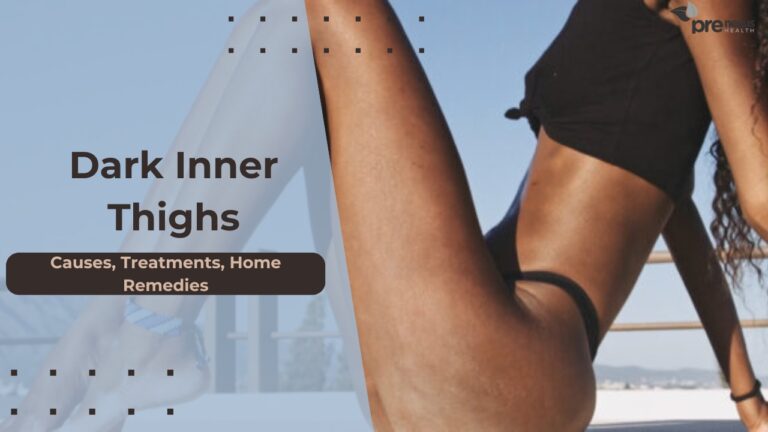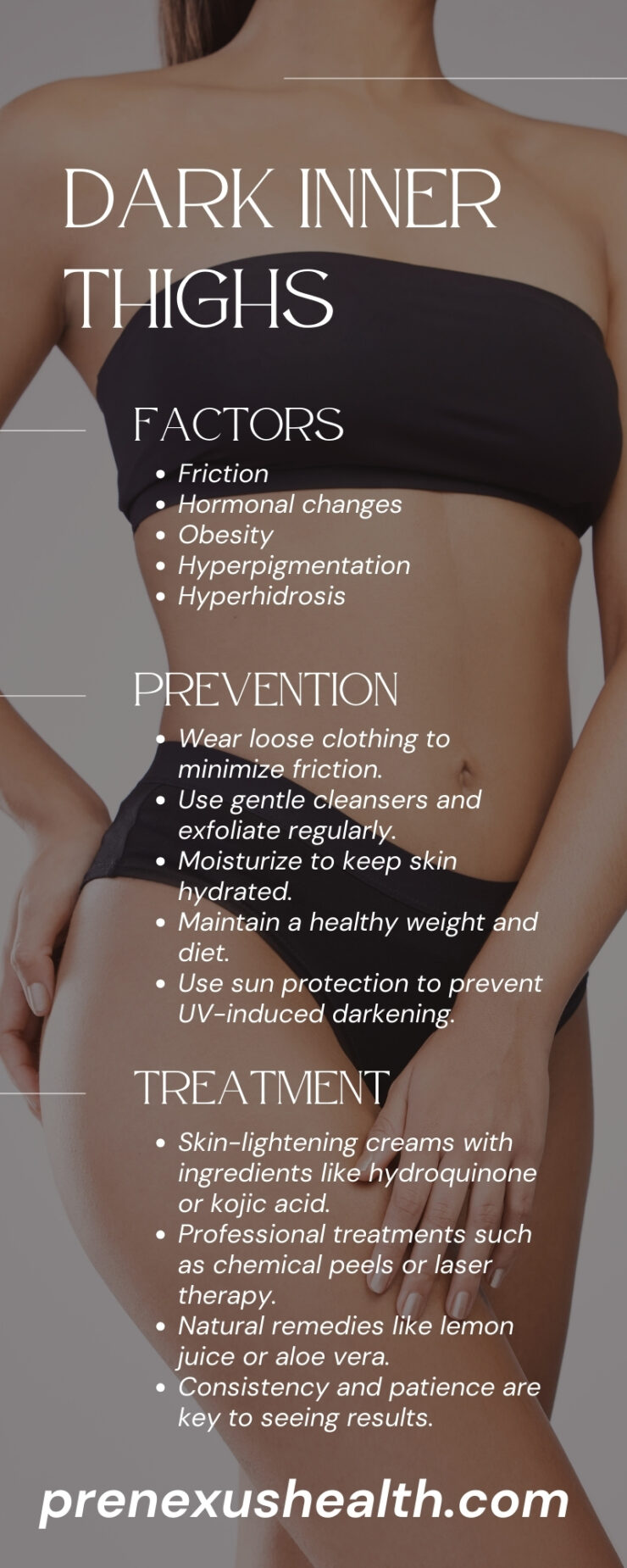Dark inner thighs can be a source of embarrassment for many people. This common skin issue, though harmless, can impact self-esteem and confidence, especially now when we’re in the summer season, wearing shorts, bathing suits, or intimate clothing. Also, noticeable darkening in this region can sometimes indicate certain health or lifestyle factors that may need attention.
You should know the causes of this issue and the available treatments so you can take the first step to addressing it. And that’s how I want to help you – I want to explain why this happens, how to prevent it, and the effective methods to lighten the skin in this sensitive area.
What Are the Causes of Dark Inner Thighs?
There are several factors that can contribute to the darkening of the skin in the inner thigh area. Let’s explore these causes in more detail:
Friction
The constant rubbing of the thighs together or wearing tight clothing can lead to friction, resulting in darkening of the skin over time. The repetitive frictional force can cause irritation and inflammation, leading to hyperpigmentation.
Hormonal changes
Hormonal fluctuations, such as those experienced during pregnancy or menstruation, can trigger changes in melanin production. This hormonal imbalance can contribute to hyperpigmentation in the inner thigh region.
Obesity

Excess weight and obesity can increase the degree of friction between the thighs, leading to darkening of the skin. The accumulation of fat in the inner thigh area can intensify the rubbing motion, causing skin discoloration. This can contribute to a higher risk of developing cardiovascular disease, a prevalent health concern in the United States.
Hyperpigmentation
Dark inner thighs can be caused by hyperpigmentation, which occurs due to the overproduction of melanin, the pigment responsible for skin color. Factors such as sun exposure, hormonal changes, certain medications, and inflammation can trigger excessive melanin production, leading to dark patches in this area.
Hyperhidrosis
Excessive sweating, known as hyperhidrosis, can also contribute to dark inner thighs. Sweat can cause irritation and lead to the skin’s darkening, especially when combined with the friction of the thighs rubbing together. If you’re prone to sweating, regular bathing, and the use of moisture-absorbing powders can be beneficial.
How to Get Rid of Dark Inner Thighs?
Consider Your Lifestyle and Habits

Firstly, you need to examine your lifestyle and habits, for example, consider the clothing you wear. Tight undergarments and trousers can cause constant friction that irritates and darkens the skin over time. If this is a significant part of your wardrobe, consider integrating looser clothing options.
I had a friend who was a huge fan of ultra-skinny jeans, and she had been wearing them for years. And guess what? Her inner thighs simply darken with each passing year.
Use Gentle Cleansing and Exfoliation
Proper cleansing and exfoliation can help treat and prevent dark inner thighs. Use a gentle, hydrating cleanser to remove any sweat, dirt, or bacteria from the area. Avoid harsh soaps that can strip the skin of its natural oils and exacerbate irritation and darkening.
Exfoliation is also crucial in removing the build-up of dead skin cells, which can contribute to darkening. You can use a gentle scrub or an exfoliating glove once or twice a week. Remember that the skin in this area is sensitive, so it’s essential to avoid harsh or abrasive scrubs that can cause inflammation and further darkening.
While exfoliating, be gentle and use circular motions to improve blood circulation to the area. This not only helps in the removal of dead skin cells but also promotes healthier skin regeneration. After exfoliating, always remember to moisturize to soothe the skin and prevent dryness.
Moisturize and Nourish the Skin

Keeping the skin moisturized can play a significant role in preventing and treating dark inner thighs. Regularly applying a nourishing moisturizer helps maintain the skin’s health, keeps it hydrated, and prevents dryness and irritation that can lead to darkening.
When choosing a moisturizer, look for ingredients like hyaluronic acid and ceramides that help lock in moisture, and vitamin E that promotes skin health. Natural ingredients like aloe vera and shea butter (my personal favorite) also offer soothing and moisturizing benefits.
In addition to a regular moisturizer, consider using creams specially designed for brightening the skin. These creams often contain active ingredients that can help lighten dark spots and even out the skin tone. But, it’s important to use these products sparingly and follow the instructions carefully to avoid skin irritation.
What Treatments and Creams Can Help?
There are numerous skin-lightening treatments and creams available in the market designed to address hyperpigmentation and dark spots. These products contain ingredients that inhibit melanin production, the pigment responsible for skin color.
Hydroquinone is a commonly used ingredient in lightening products. It works by decreasing the number of melanocytes, the cells that produce melanin. However, it should be used under the guidance of a healthcare professional due to its potential side effects.
Other ingredients to look for include kojic acid, a by-product of rice fermentation that’s often used in Japanese skincare, and alpha arbutin, a natural compound found in many plants. These ingredients are generally gentler than hydroquinone and can effectively lighten dark spots over time with regular use.
Remember, when using these products, consistency is key. Also, it’s important to perform a patch test to ensure you’re not allergic to any of the ingredients, and always follow the product’s instructions for use.
Use Natural Home Remedies
If you prefer natural remedies, there are several effective at-home treatments available to help lighten your thighs:
Lemon Juice

Lemon juice is renowned for its high vitamin C content, which acts as a natural skin brightener. The acidic properties of lemon juice help exfoliate the skin, remove dead skin cells, and lighten dark spots.
But, you shouldn’t put lemon juice directly on your skin, so mix it with coconut oil. Allow the mix to sit for about 10 minutes, then rinse off with lukewarm water. Repeat this treatment a few times a week for best results.
Aloe Vera
Aloe Vera is widely known for its healing properties and can also help. Extract fresh aloe Vera gel from the leaves or use store-bought pure gel. Apply a generous layer of aloe vera gel to the affected area and leave it on for about 20 minutes. Then, rinse off with water.
It will help in the lightening of your inner thighs, but it also moisturizes and soothes the skin. Repeat this remedy a few times a week to see visible improvements.
Cucumber

Cucumber is packed with water content and contains skin-lightening agents like cucurbitacin, which can help reduce hyperpigmentation and lighten dark areas.
Take a fresh cucumber slice and rub it gently on your inner thighs for a few minutes. Alternatively, you can grate the cucumber and apply the grated pulp directly to the skin. Leave it on for 15-20 minutes and then rinse off with cool water. Regular application can contribute to brighter and more even-toned skin.
Turmeric Paste
Turmeric is a natural ingredient known for its anti-inflammatory and brightening properties. Create a paste by mixing turmeric powder with milk or water to achieve a smooth consistency.
Apply the paste to your inner thighs and leave it on for about 15-20 minutes. Rinse off with lukewarm water. Turmeric may leave a slight yellowish tint on the skin, but this will fade away after washing.
Remember, natural remedies often require time and consistency to show results. It’s important to be patient and persistent with these treatments. Additionally, before using any new ingredient, perform a patch test on a small area of the skin to check for any adverse reactions or allergies.
If you experience any discomfort, itching, or redness, discontinue use immediately.
Maintain Healthy Body Weight and Nutrition

A healthy body weight and good nutrition can impact the skin’s condition. Obesity can lead to an increase in friction between the thighs, resulting in skin darkening.
Adopting a balanced diet rich in fruits, vegetables, lean proteins, and healthy fats can aid in maintaining a healthy weight. Foods rich in antioxidants, like berries and leafy greens, can help promote healthy skin and may help reduce hyperpigmentation.
Regular physical activity is also crucial in maintaining a healthy weight. Even simple exercises like walking can help reduce the friction between the thighs, reducing the chances of skin darkening.
Prevent Friction and Irritation
Wear breathable fabrics and avoid overly tight clothing as it can reduce the amount of friction that your thighs experience.
Consider using moisture-absorbing powders to minimize chafing and irritation, especially during hot weather or when exercising. Applying petroleum jelly or using anti-chafing bands can also help reduce friction and thus the risk of skin darkening.
Regularly changing out of sweaty clothes and bathing after a workout can also help prevent irritation and keep the skin clean and healthy.
Use Sun Protection

Inner thighs are typically less exposed to the sun, but it’s still essential to protect them from UV rays, especially if you spend a lot of time outdoors in shorts or bathing suits. Sun exposure can exacerbate hyperpigmentation and dark spots.
Use a broad-spectrum sunscreen with an SPF of at least 30 on your inner thighs if they’re exposed to the sun. Wearing UV-protective clothing or keeping your thighs covered during peak sun hours can also help prevent sun-induced hyperpigmentation. Remember to reapply sunscreen every two hours and after swimming or sweating for continued protection.
Women in their 60s and 70s should opt for moisturizing sunscreens that provide both UV protection and hydration to combat the natural dryness that comes with aging.
Get Professional Help
If your dark inner thighs are causing you significant distress or if you’re not seeing results from at-home treatments, consider consulting a dermatologist or aesthetician. These professionals can assess your skin and suggest appropriate treatments based on your individual needs.
Medical procedures like chemical peels, laser therapy, and microdermabrasion can be effective in treating hyperpigmentation. These treatments work by removing the top layer of the skin to reveal a lighter, more even skin tone beneath.
Always remember to follow up with your healthcare provider and adhere to their guidelines for post-treatment care to achieve the best results.
Consistency and Patience Are the Key

When it comes to skincare, consistency is key. Whether you’re applying a lightening cream, using a natural remedy, or making lifestyle changes, you’ll need to maintain these routines regularly to see results.
But, skin lightening is a gradual process, and changes may not be noticeable overnight. It requires patience. Stick with your routine, and don’t be discouraged if the results take time to appear.
If you’re using a new product, remember that it may take a few weeks to see an effect. As long as the product is not causing any adverse reactions, such as irritation or increased darkening, keep using it as directed by the product instructions or your healthcare provider.
Conclusion
Dark inner thighs are a common concern, but with the right knowledge and consistent efforts, they can be effectively addressed.
In the end, remember that everyone’s skin is unique, and what works for one person may not work for another. Stay patient and persistent, and with time, you can achieve your desired results. Most importantly, embrace your body as it is, love it, and remember that beauty comes in all shapes, sizes, and colors.
Discover effective solutions for addressing discoloration and discomfort in the leg area, including an exploration of various causes, small and itchy dots, as well as non-itchy red spots on the legs.
I’m a dermatologist who loves studying and treating skin (obviously). I went to medical school and chose dermatology because I wanted to help people with skin problems. I’m dedicated to helping people feel better about their skin (and in it).
Related Posts:
- How To Get Rid Of Blackheads On Cheeks - 10 Approved Hacks
- 5 Most Effective Home Remedies For Loose Motion
- Rashes From Pads: Causes, Symptoms, Treatments, How…
- Rash Under Breast: Causes, Symptoms, Treatments, How…
- Itchy Palms: Causes, Symptoms, Remedies, and Treatment
- Frequent Urination with Diabetes - Causes, Symptoms,…





